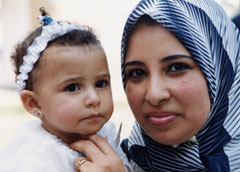World Population Day – July 11, 2005

|
A woman and her infant attend an event promoting family planning/reproductive health among youth in Port Said, Egypt.
Source: ©2001 William Mackie/CCP, Courtesy of Photoshare |
Equality Empowers
From the beginning of time until about 1800, the world population totaled less than 1 billion people. At the current growth rate of approximately 80 million people a year, 1 billion people will be added to the world every 12 years. At this rate, the world adds a New York City every month, a Germany every year, and an India each decade. On July 11, 1987, the United Nations (UN) first commemorated World Population Day when the world's population reached 5 billion. Most of the world's population growth – about 98 percent – is taking place in developing countries where USAID works and is expected to grow until the middle of the century.
"Equality goes hand-in-hand with investments in education, economic opportunity and reproductive health, and taken together, these are a powerful force for lifting millions out of poverty...
On this World Population Day, let us resolve to empower women and girls by our commitment to gender equality." |
| - Kofi Annan, UN Secretary-General (read the full message) |
This year marks the 16th World Population Day and focuses on the theme "Equality Empowers," reminding us that each woman and girl is a distinct
human being deserving of equal opportunities and universally accepted
human rights. USAID's Office of Population and Reproductive Health (PRH) is
celebrating World Population Day by remembering its important achievements in the last 40 years and highlighting a select number of
successful family planning programs.
USAID’s Office of Population and Reproductive Health

|
| |
Source: © Lutheran World Relief,
Courtesy of Photoshare |
With 40 years of experience, USAID has been the world leader in supporting voluntary family planning programs in developing countries. Since 1965, USAID programs in family planning have been committed to helping men and women achieve their desired family size.
USAID’s family planning programs:
- Provide modern methods of contraception to hundreds of millions of couples annually
- Save the lives of tens of thousands of mothers and children and enhance their health and well-being
- Slow population growth and reduce poverty
As a result of USAID achievements in this area, the average number of children per family has dropped from more than six to less than four. Modern contraceptive use has more than quadrupled, from less than 10 percent to more than 50 percent. Researchers estimate that without organized and successful family planning programs, there would be an additional half billion people inhabiting the world today.
USAID Family Planning Program Timeline: Before 1965 to the Present
USAID Program Examples
Addressing Family Planning Needs in Bangladesh
In Bangladesh, USAID has enhanced the quality of life of the Bengali population by addressing critical reproductive and family health needs for 30 years. The USAID health and population program in Bangladesh works with over more than 40 nongovernmental organizations (NGOs) to provide integrated family planning and maternal and child health programs to a population of more than 22 million. Since the inception of the program in the 1970s, the total fertility rate has declined from 7 births per woman to 3.3 in 2000. Additionally, contraceptive use has increased from 8 percent in the mid-1970s to 54 percent in 2000. Programs, such as the one in Bangladesh, show the effectiveness of quality and voluntary family planning programs.

|
| |
Three Senoufo teenage girls in the village of Kanoroba, Cote d'Ivoire. Source: © 1999 Aimee Centivany, Courtesy of Photoshare |
Extending Services in India
In three states in northern India, home to more than 210 million people, approximately 20 to 25 percent of married women are at risk of unintended pregnancy. In response, USAID has supported the Innovations in Family Planning Services project, one of the largest family planning programs in the world. To improve the supply and quality of family planning services and access to them, the project formulated district-specific action plans that took into account the unique resources and environments of individual districts. In 2004, the Indian government adopted the district guidelines developed by USAID for use in the national reproductive and child health program. This effort greatly increases the impact of USAID’s past investments.
Increasing Family Support for Family Planning in Ethiopia
In Ethiopia, women may not use contraception because of perceived or real opposition from their husbands. Other barriers can include the attitudes of mothers-in-law, extended families, and communities. USAID has developed programs so all members of a family can be educated to be more supportive of women's reproductive decisions. In Ethiopia, USAID supported projects that developed clinic-, community-, and workplace-based services, established health centers for young people, and worked with local NGOs, including the Ethiopian Evangelical Church. From this effort came the country's first community-based reproductive health (CBRH) services program involving farmers, factory workers, dress makers, artisans, and housewives as agents to help provide improved health and family welfare at the grassroots level in both rural and urban areas.
Resources
|


